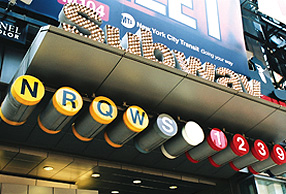Although New York had long been the most heterogeneous city in the world, it took rapid transit to bring diverse social groups into regular contact. New Yorkers reacted differently to subway riding. For some, the subway’s speed and technology had a liberating, euphoric effect. Many other riders, though, resented the personal indignities of overcrowding and disliked being trapped in a small, confined space. When ethnic, gender and class differences were added to overcrowding and claustrophobia, the riding experience could be anxiety provoking.
The first subway route was the product of a mercantile elite. In 1913, though, a second stage of subway construction was authorized. The dual contract system, as it was known, was conceived by progressive reformers as an ambitious experiment in social planning designed to alleviate urban poverty and to assimilate immigrants. The dual system doubled the city’s rapid transit mileage to serve outlying portions of the Bronx, Queens and Brooklyn and allowing working class residents to move to new areas on the outskirts.
The subway contributed to the modern city by reinforcing the extent to which New York’s spatial pattern differed from that of other big American cities. New York City is among the few U.S. cities that departs from the “doughnut” pattern of low-income and decreasing population in the center and high-income and increasing population on the periphery. New York is centered on Manhattan, which has a population that is both comparatively affluent and that has high residential densities, a combination that contributes to many of the city’s characteristics: its rapid pace, its emphasis on consumption and fashion and its 24-hour operation.
Most New Yorkers live in apartments. Every morning, hundreds of thousands empty out of their apartments and commute to midtown and lower Manhattan; every night they return home. Rapid transit’s ability to transport large numbers of people quickly and efficiently permits the dense concentration of nighttime populations in residential neighborhoods and daytime populations in midtown and Wall Street.
The subway also figures in the spatial and social gulf that divides New York City from its suburbs. New York City has the nation’s highest population densities, while its suburbs extend farther than any other.
|
Avenue Subway Construction, 16th Street. 1937 |
The New York region’s distorted transportation planning is largely responsible for this. When the third and last major phase of subway construction came to an end in 1940, the metropolis became committed to the automobile and almost all new improvement consisted of vehicular highways. More than ever before, the subway set New York City apart.
While New York has had to support its own transit network, cities such as Houston and Atlanta for their transportation rely on interstate highways, which have been financed by the federal government. Beginning in the 1960s, the federal government recognized that mass transit could no longer be dealt with on a local level. The Urban Mass Transit Act of 1964 initiated federal funding of transit construction. During the resulting boom, a number of cities built light-rail systems. Because these federal subsidies have been targeted to promote the construction of new lines rather than underwrite service or the rehabilitation of existing systems, New York City had to maintain its aging subway system largely by itself, a formidable undertaking at a time when the departure of middle-class residents to the suburbs was eroding its tax base.
The failure to correct the subway’s chronic fiscal problems, along with growing competition from the private automobile after World War II, led to the system’s near collapse in the 1970s. The subway has recently experienced a renaissance, however. Since the late 1980s, the Metropolitan Transportation Authority has rebuilt every miles of track, refurbished dozens of stations and acquired hundreds of new cars. It is now considering the construction of the first new subway lines in decades, including the famously delayed Second Avenue route.
 |
There is nonetheless good reason for caution. The new lines remain in planning stages and are at the mercy of changing political currents and economic conditions. Moreover, the subway’s renewal is imperiled by the financial constraints of the municipal government and the disregard of the federal government. Still, because the progress that has been made has created a new sense of hope and possibility, the subway’s second century looks promising: New Yorkers are not through making history with the subway. Clifton Hood, an associate professor of history at Hobart and William Smith Colleges in Geneva, N.Y., is the author of “722 Miles: The Building of the Subways and How They Transformed New York.”
This article is excerpted from the spring 2004 issue of “The New-York Journal of American History,” the semiannual publication of the New-York Historical Society.

